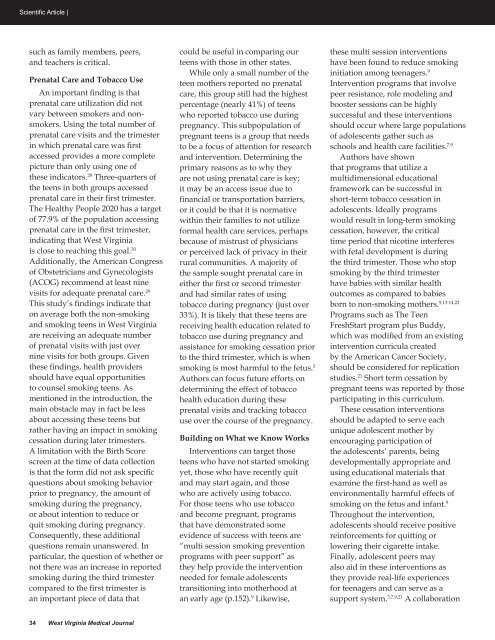Adam E. Klein, MD - West Virginia State Medical Association
Adam E. Klein, MD - West Virginia State Medical Association
Adam E. Klein, MD - West Virginia State Medical Association
You also want an ePaper? Increase the reach of your titles
YUMPU automatically turns print PDFs into web optimized ePapers that Google loves.
Scientific Article |such as family members, peers,and teachers is critical.Prenatal Care and Tobacco UseAn important finding is thatprenatal care utilization did notvary between smokers and nonsmokers.Using the total number ofprenatal care visits and the trimesterin which prenatal care was firstaccessed provides a more completepicture than only using one ofthese indicators. 29 Three-quarters ofthe teens in both groups accessedprenatal care in their first trimester.The Healthy People 2020 has a targetof 77.9% of the population accessingprenatal care in the first trimester,indicating that <strong>West</strong> <strong>Virginia</strong>is close to reaching this goal. 30Additionally, the American Congressof Obstetricians and Gynecologists(ACOG) recommend at least ninevisits for adequate prenatal care. 29This study’s findings indicate thaton average both the non-smokingand smoking teens in <strong>West</strong> <strong>Virginia</strong>are receiving an adequate numberof prenatal visits with just overnine visits for both groups. Giventhese findings, health providersshould have equal opportunitiesto counsel smoking teens. Asmentioned in the introduction, themain obstacle may in fact be lessabout accessing these teens butrather having an impact in smokingcessation during later trimesters.A limitation with the Birth Scorescreen at the time of data collectionis that the form did not ask specificquestions about smoking behaviorprior to pregnancy, the amount ofsmoking during the pregnancy,or about intention to reduce orquit smoking during pregnancy.Consequently, these additionalquestions remain unanswered. Inparticular, the question of whether ornot there was an increase in reportedsmoking during the third trimestercompared to the first trimester isan important piece of data thatcould be useful in comparing ourteens with those in other states.While only a small number of theteen mothers reported no prenatalcare, this group still had the highestpercentage (nearly 41%) of teenswho reported tobacco use duringpregnancy. This subpopulation ofpregnant teens is a group that needsto be a focus of attention for researchand intervention. Determining theprimary reasons as to why theyare not using prenatal care is key;it may be an access issue due tofinancial or transportation barriers,or it could be that it is normativewithin their families to not utilizeformal health care services, perhapsbecause of mistrust of physiciansor perceived lack of privacy in theirrural communities. A majority ofthe sample sought prenatal care ineither the first or second trimesterand had similar rates of usingtobacco during pregnancy (just over33%). It is likely that these teens arereceiving health education related totobacco use during pregnancy andassistance for smoking cessation priorto the third trimester, which is whensmoking is most harmful to the fetus. 5Authors can focus future efforts ondetermining the effect of tobaccohealth education during theseprenatal visits and tracking tobaccouse over the course of the pregnancy.Building on What we Know WorksInterventions can target thoseteens who have not started smokingyet, those who have recently quitand may start again, and thosewho are actively using tobacco.For those teens who use tobaccoand become pregnant, programsthat have demonstrated someevidence of success with teens are“multi session smoking preventionprograms with peer support” asthey help provide the interventionneeded for female adolescentstransitioning into motherhood atan early age (p.152). 9 Likewise,these multi session interventionshave been found to reduce smokinginitiation among teenagers. 9Intervention programs that involvepeer resistance, role modeling andbooster sessions can be highlysuccessful and these interventionsshould occur where large populationsof adolescents gather such asschools and health care facilities. 7,9Authors have shownthat programs that utilize amultidimensional educationalframework can be successful inshort-term tobacco cessation inadolescents. Ideally programswould result in long-term smokingcessation, however, the criticaltime period that nicotine interfereswith fetal development is duringthe third trimester. Those who stopsmoking by the third trimesterhave babies with similar healthoutcomes as compared to babiesborn to non-smoking mothers. 9,13-14,22Programs such as The TeenFreshStart program plus Buddy,which was modified from an existingintervention curricula createdby the American Cancer Society,should be considered for replicationstudies. 21 Short term cessation bypregnant teens was reported by thoseparticipating in this curriculum.These cessation interventionsshould be adapted to serve eachunique adolescent mother byencouraging participation ofthe adolescents’ parents, beingdevelopmentally appropriate andusing educational materials thatexamine the first-hand as well asenvironmentally harmful effects ofsmoking on the fetus and infant. 9Throughout the intervention,adolescents should receive positivereinforcements for quitting orlowering their cigarette intake.Finally, adolescent peers mayalso aid in these interventions asthey provide real-life experiencesfor teenagers and can serve as asupport system. 3,7,9,21 A collaboration34 <strong>West</strong> <strong>Virginia</strong> <strong>Medical</strong> Journal















